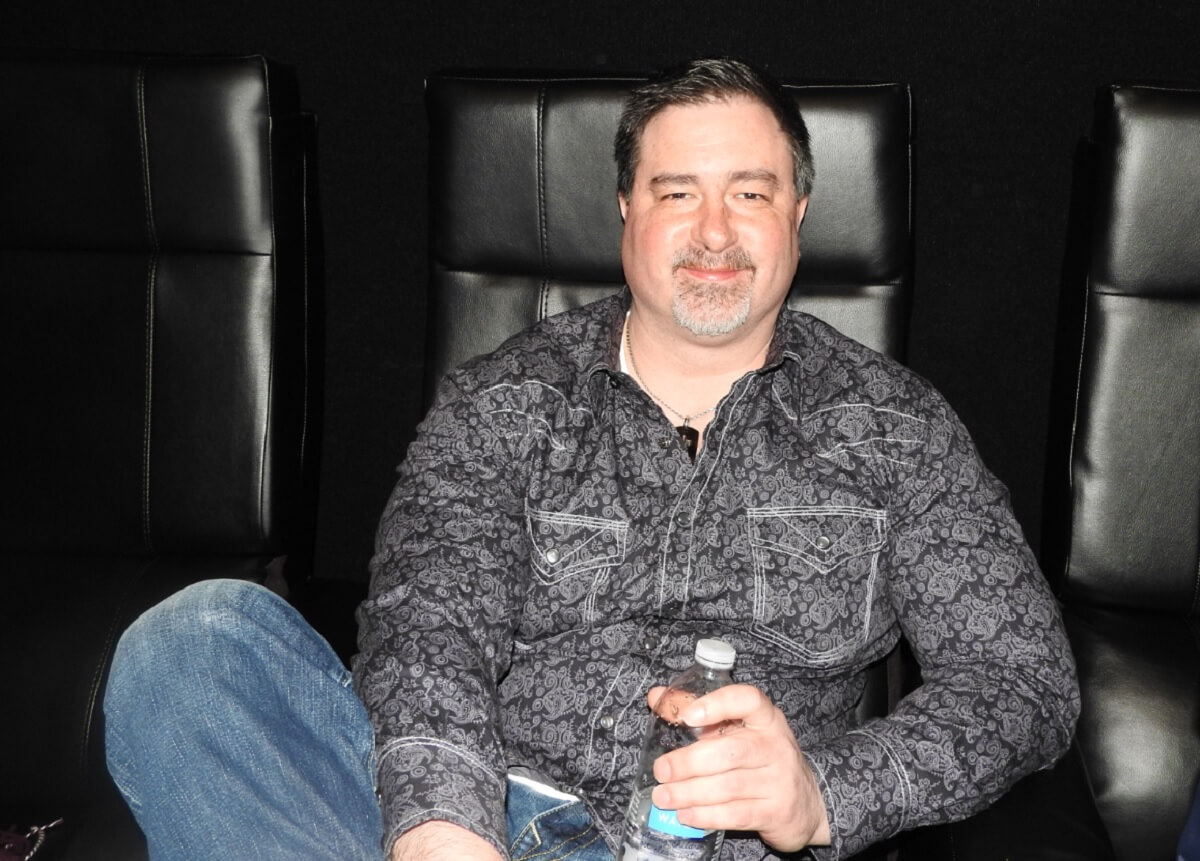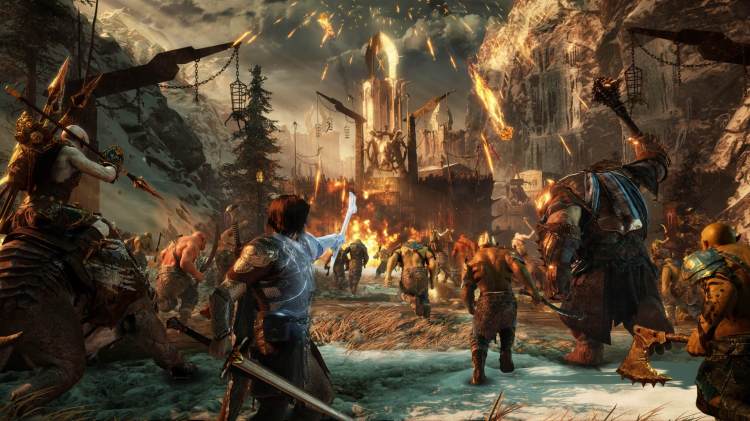Warner Bros. Interactive Entertainment spilled the beans last week on Middle-earth: Shadow of War. GamesBeat’s Mike Minotti and I went to a preview event to see the first gameplay demo during the Game Developers Conference in San Francisco a week ago.
The title comes out August 22 for PlayStation 4, Xbox One, and PC. For me and many other fans, it is a long-awaited sequel to Shadow of Mordor, set in the early Third Age of J.R.R. Tolkien’s fantasy realm Middle-earth. The first tale — a prequel to The Lord of the Rings — was about the ranger Talon, who fought his way through Mordor with the wraith elf Celebrimbor. Their quest is to deny Sauron of the Rings of Power, and it turned out to be my favorite game of 2014.
Now the sequel looks like it will be far more massive than Shadow of Mordor, which took me 80 hours to finish. Talon, now called the Bright Lord (in opposition to Sauron, the Dark Lord), is leading big orc armies to take over Mordor, one stronghold at a time.
We caught up with Philip Straub, the art director at developer Monolith Productions, in a small press interview during the Game Developers Conference in San Francisco last week.
Here’s an edited transcript of our conversation.

Above: Philip Straub is art director on Warner’s Shadow of War.
GamesBeat: It looks like a much bigger world, from what I could tell.
Philip Straub: Absolutely. It’s interesting, because the game in general is just an order of magnitude larger, across so many axes. It’s a larger world, more places to go, more diverse geography, more diverse biomes. We have nemesis fortresses, more enemies, more AI. It’s just bigger.
GamesBeat: Can you give us an idea of the structure of the game? In Shadow of Mordor, you were in a region with the different levels of orcs, and then captains and war chiefs and so on. In this one, it seems like each fortress has its own ecosystem.
Straub: Right, that’s correct.
GamesBeat: Do you fight them all at once?
Straub: I’ll try to answer that from two ways. From the art standpoint, we have different regions. We highlighted those on the world map. When an overlord owns a fortress, that level, a bunch of things happen. The look of the fortress changes. You noticed that the first fortress we showed had a certain look to it. That was the Terror tribe. And then you notice at the end it had a different look. That was the Marauder tribe.
Also, as the fortress changes, the gameplay associated with it changes. The Feral tribe owns an area, so it has a bunch of beasts around it, and it can bring various other traits. But it gets much bigger than that. There’s the fortress, but then there’s the approach all around it in the world. The gameplay changes in those outposts, and the visuals change as well. Even cooler, and what I’m excited about, is that the overlords bring their own lighting palette and weather. When an overlord owns a region, a specific level, the whole place changes.

Above: Yours for the taking.
In terms of structure—I can’t really get into the specifics of the Nazgul, other than that they’re in the game right now. But there is a wide variety of enemies you get to encounter. We’ve shown a few. We showed the Olog-Hai. We showed our drake. But back to structure, it’s an open-world sandbox game. There’s going to be all kinds of emergent missions occurring based on the story campaign, based on side missions, and based on your interactions with the AI and the nemesis system. More gameplay opportunities are going to present themselves. You’ll be doing a number of different things within each region. Just one of your goals is taking down these fortresses, one of the big meta-goals.
The other thing that’s nice—in Shadow of Mordor we had the nemesis system and the campaign, but they weren’t really intertwined. Now they’re much more intertwined.
GamesBeat: One of the big things in the original game was riding around in the overworld, and captains would show up to mess around with you. But it seems like the overlords, with their captains and everything, are more self-contained. It’s one big encounter when you fight them. In the sandbox area, are you going to continue to encounter captains and things like that?
Straub: Absolutely. You’ll get all the great things we had in Shadow of Mordor, and then this whole other concept of the nemesis fortresses, the nemesis followers, and your ability to build this huge army to take down the fortresses and ultimately take down Sauron’s forces.
GamesBeat: Is the world map, the one we were shown, sort of like the hub?
Straub: I’d say you could call it the hub, yeah. It’s where you get your highest-level information in terms of your interactions with the world. Then you can go down into what we call our region maps. That gives you more information in terms of missions and everything you can do in there. Also within that you have your army screen, your hierarchy screen, that’s associated with each of the regions. Each of those is completely different relative to where you are in the game and relative to your interactions with the game.
GamesBeat: In the sandbox area, can you freely travel from one fortress to another and see stuff in between?
Straub: You can, as you become more powerful.

Above: Middle-earth: Shadow of War has some seriously harsh combat.
GamesBeat: Some of the fortresses looked a little cookie-cutter. Are there certain classes of fortresses that are the same?
Straub: There’s a huge amount of content and variety of content that we’ve created to assign unique visuals to them relative to the character and personality. If you think about it this way—in Shadow of Mordor we had those unique personal villains. Now we’ve attached that to the fortresses in the world. Those are quite unique.
There’s a ton of dynamic content, too. What we showed in the main gameplay portion – not the army screen – were at a certain level, but there are multiple levels for the fortresses. Those levels change the way they look in the world.
GamesBeat: So you have your captains, your war chiefs, and then your overlords. Are the overlords going to be bespoke or totally random?
Straub: They’re totally nemesis generated, not bespoke at all.
GamesBeat: So the game generates, at the beginning — these guys will be your uber-enemies.
Straub: Anybody can be an uber-enemy. Somebody can get promoted to that. Everybody can start out as a grunt and get promoted all the way up to overlord.
GamesBeat: I remember in Shadow of Mordor, there were the four super high-level enemies. I remember them being bespoke?
Straub: Yes, yes. You’re talking about the Black Hand, some of those guys. We’ve spent a lot more time focusing on building up the nemesis system so that we don’t need those, as you say, bespoke enemies. It’s all about those player stories, having each player enjoy a unique playthrough.
GamesBeat: But they have their own unique encounter areas?
Straub: One thing we showed today was the throne rooms. So yes, each fortress has a throne room, and that’s generally where you’re going to encounter the overlord. But those are also very dynamic. The way we were talking about all the tribes and how that affects orc culture and society, how that affects the exterior of the fortresses, it also affects the interior of the fortresses. They’ll look different. They’ll have different gameplay components. Sometimes those guys are going to have bodyguards. Sometimes there will be more enemies, or less. Sometimes there will be beasts. Just a huge amount of variety there.
GamesBeat: If Shadow of Mordor took 80 hours to finish, in a straight line — are we talking about a lot more time here?
Straub: The way to think about it is that the game in general is an order of magnitude bigger across multiple axes. We’re still tuning and refining, so we don’t have a number as to how many hours it’ll take. But it’s quite a bit larger. I think playthroughs are going to be pretty extensive. And then of course it just depends on how you interact with the game.
GamesBeat: You mentioned human settlements as well. Can you travel to those and interact with them? Can we expect to see allied characters?
Straub: Absolutely, yes. We have a whole host of new characters that you’re going to be able to interact with. One of the most exciting things when we talk about Shadow of War versus of Shadow of Mordor—why is it called Shadow of War? Well, one reason is because we’re not just in Mordor anymore. We’re going to the last human city in Gondor in this time period. Even just the idea that we’re going to a city—we’ll actually be playing in this massive city. That’s quite a level up compared to Shadow of Mordor.
GamesBeat: Can you tell us about what aspects of the lore from the novels you wanted to focus on for this game?
Straub: We obviously respect the lore a great deal. We’re all big fans. Michael is the lore expert. I try to do my best, especially in terms of the authenticity of the art and other content we create. We also work closely with Middle-Earth Enterprises. For this go-round it’s not one particular thing we focused on. We’re always focused on trying to make sure we’re staying true to the lore, but also expanding the components we need to make a great game.
GamesBeat: Is there a bookend here to the lore, though? The Last Alliance of Elves and Men?
Straub: Those are things that—we don’t want to share any spoilers at this point. I don’t want to get that far ahead. Your primary goal is to take down the forces of Sauron and build your own army, build that set of followers.

